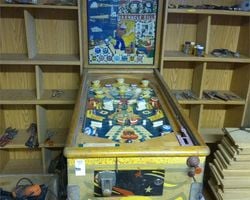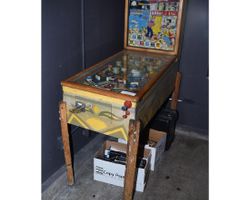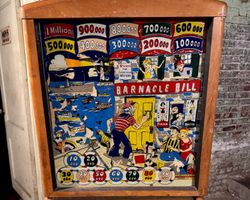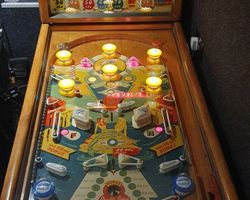Barnacle Bill

Average Prices: USD $500 to $1,000
Produced: August, 1948
Production Run: 2,500 units
Machine Type: Electro-mechanical
Players: 1
Design by: Harry Mabs
Art by: Roy Parker
Barnacle Bill, released by D. Gottlieb & Co. in July 1948, emerged during a pivotal era for pinball, as the industry transitioned from simple amusement devices to more interactive games. This electro-mechanical (EM) machine, bearing model number 8, was a product of Gottlieb's burgeoning dominance in the market. The game's nautical theme, centered around the jovial character of Barnacle Bill, likely drew inspiration from popular culture of the time, including the well-known folk song "Barnacle Bill the Sailor." This theme provided a vibrant backdrop for the machine's design elements.
The creative forces behind Barnacle Bill were Harry Mabs, responsible for the game's design, and Roy Parker, who brought the visual theme to life through his artwork. Mabs, a prolific designer for Gottlieb, contributed to numerous successful titles throughout his career, known for creating layouts that balanced challenge with engaging play. Parker's artistic touch was crucial in establishing the visual identity of Gottlieb machines, lending them a distinctive charm and appeal. The collaboration between these individuals ensured that Barnacle Bill was not only mechanically sound but also visually captivating. With a production run of 2,500 units, Barnacle Bill became a notable release for Gottlieb in the immediate post-World War II period, a time when pinball was experiencing a resurgence in popularity and innovation, particularly with the widespread adoption of player-controlled flippers.
Signature Features and Design
Barnacle Bill distinguishes itself through several key features that shaped its gameplay. Foremost among these are its four flippers, a significant number for a 1948 machine. While contemporary machines often featured two, the inclusion of four flippers allowed for a wider range of shot opportunities and a more dynamic playfield interaction. These flippers, strategically placed, provided players with increased control over the ball, differentiating it from earlier, more passive pinball games.
In addition to the flippers, the playfield incorporated ten passive bumpers. Unlike later pop bumpers that actively propel the ball, these passive bumpers relied on the ball's momentum for deflection, adding an element of unpredictability to the game's flow. Their placement was crucial in directing the ball's movement towards scoring opportunities or setting up flipper shots. A single kick-out hole served as a notable objective, often rewarding players with higher points or bonus sequences upon the ball's entry. These elements collectively defined the interactive experience, requiring players to develop skill in controlling the ball's trajectory and anticipating its rebounds. Roy Parker's artwork, a consistent highlight for Gottlieb machines, imbued Barnacle Bill with a lively nautical aesthetic across both the playfield and the backglass. The backglass, illuminated and often featuring whimsical depictions of Barnacle Bill and sea creatures, contributed significantly to the machine's overall thematic appeal and visual charm.
Playfield and Mechanics
The playfield layout of Barnacle Bill, though lacking modern ramps or drop targets, was meticulously designed to maximize interaction with its flippers, passive bumpers, and kick-out hole. The four flippers were likely positioned to offer varied control points—perhaps a pair at the bottom for primary saves and another pair higher up or on the sides to facilitate specific shots or traps. This configuration encouraged players to utilize all available flippers, learning their sweet spots and the angles they provided. The ten passive bumpers were strategically scattered across the upper and mid-playfield, creating a dynamic environment where the ball would carom unpredictably. Each bumper hit registered points, making them central to the scoring strategy.
The design philosophy behind the layout emphasized ball longevity and skillful manipulation rather than complex rule sets. The objective was clear: keep the ball in play, hit as many scoring elements as possible, and aim for the kick-out hole for higher rewards. The open nature of the playfield, typical of EM games from this era, allowed for longer ball times for skilled players, fostering a sense of mastery. The artwork on the playfield maintained the vibrant nautical theme, with illustrations of shipwrecks, mermaids, and various sea life adorning the surface. The lighting system, inherent to EM machines, used incandescent bulbs to highlight scoring zones and provide visual feedback, contributing to the engaging aesthetic. The overall design ensured that while the game's mechanics were straightforward, the interplay of the flippers, bumpers, and kick-out hole offered a consistent challenge and a captivating visual experience.
Gameplay Dynamics
Barnacle Bill’s gameplay dynamics revolved around mastering ball control and navigating a playfield designed for rapid action. The scoring system was point-based, with players accumulating points by hitting the numerous passive bumpers and successfully guiding the ball into the kick-out hole. The primary objective was to achieve a high score, often with the goal of earning a replay by surpassing a set threshold. Given its 1948 vintage, the machine did not feature complex modes or multi-ball play, which are characteristics of later solid-state pinball machines. Instead, its challenge stemmed from the physical interactions of the ball with the electromechanical components.
A distinct characteristic, noted by players, is the need for an adjustment period to become accustomed to the machine's unique flipper configuration, which some have described as "reversed." This might imply that the flippers' action or their layout deviated from conventional expectations, demanding players to recalibrate their muscle memory and aiming strategies. Successfully navigating this unique flipper feel was integral to extended play and high scores. Players would develop strategies such as trapping the ball with the flippers to set up precise shots, nudging the machine to influence ball trajectory (a common skill in EM pinball), and timing shots to maximize bumper hits before attempting to target the kick-out hole. The unpredictable nature of the passive bumpers meant that a well-placed shot could lead to a cascade of bumper hits, rapidly increasing a player's score. The simplicity of its objectives, combined with the tactile satisfaction of controlling the ball through its unique flipper setup, made Barnacle Bill a game where fundamental pinball skills were continuously tested and refined.
Reception and Legacy
Barnacle Bill has generally garnered a positive reception, often described by players as "a lot of fun." Its appeal lies in its straightforward yet engaging gameplay, characteristic of Gottlieb’s early flipper machines. The primary strength of the machine is its ability to deliver a classic pinball experience, focusing on fundamental ball control and precision. The inclusion of four flippers, particularly for its era, provided a more dynamic and interactive playfield than many of its contemporaries, allowing for a wider range of shot opportunities and increasing player engagement. The kick-out hole also added a clear, satisfying objective beyond merely hitting bumpers.
However, feedback also points to specific challenges that can influence the player experience. The "reversed flippers" — a unique aspect of its design — demand an initial period of adjustment for players accustomed to more conventional setups. This unusual flipper configuration, while distinctive, can present a steeper learning curve. Furthermore, some machines have suffered from poor adjustments or modifications by previous owners, which can detract from the intended gameplay and lead to less-than-optimal performance. Such issues, common with older EM machines, highlight the importance of proper maintenance for a true appreciation of the game.
Despite these nuances, Barnacle Bill holds a notable place in pinball history. As an early Gottlieb flipper game from the immediate post-war period, it contributed to the evolution of pinball from pure chance-based amusements to skill-oriented games. Its production run of 2,500 units made it a relatively common machine for its time, spreading the Gottlieb brand and its design philosophy to a wide audience. The machine’s enduring appeal as an enjoyable, if sometimes challenging, experience contributes to its reputation as a significant example of Gottlieb's innovative spirit in the late 1940s, influencing subsequent designs by demonstrating the potential of multiple flipper arrangements and focused playfield objectives. Its mechanical design, embodying the characteristics of EM technology, serves as a tangible link to pinball's foundational era, preserving a style of gameplay that relies on mechanical precision and player intuition.
Sponsored Links
 Ebay Listings
Ebay Listings
 Auction Results
Auction Results
| Cost | Location | Date |
|---|---|---|
| GBP £800 |  Norwich, United Kingdom Norwich, United Kingdom |
05 April, 2025 |
| USD $300 |  Iowa, United States Iowa, United States |
18 October, 2024 |
| USD $600 |  Ohio, United States Ohio, United States |
12 September, 2024 |
| USD $600 |  California, United States California, United States |
15 September, 2018 |
| USD $500 |  Missouri, United States Missouri, United States |
11 December, 2010 |
| USD $1,146 |  Wisconsin, United States Wisconsin, United States |
25 October, 2010 |
| USD $1,200 |  Maryland, United States Maryland, United States |
30 November, 2009 |
| USD $1,375 |  South Carolina, United States South Carolina, United States |
09 February, 2009 |
| USD $1,100 |  Illinois, United States Illinois, United States |
02 March, 2008 |
| USD $511 |  United States United States |
31 July, 2007 |


Private Policy · Search Website · Contact Us
As an eBay Partner, we may earn a commission from qualifying purchases made through links on this site, at no additional cost to you.
All trademarks and copyrighted materials remain property of their respective owners. All other content copyright 2007 - 2025 Pinpedia.




